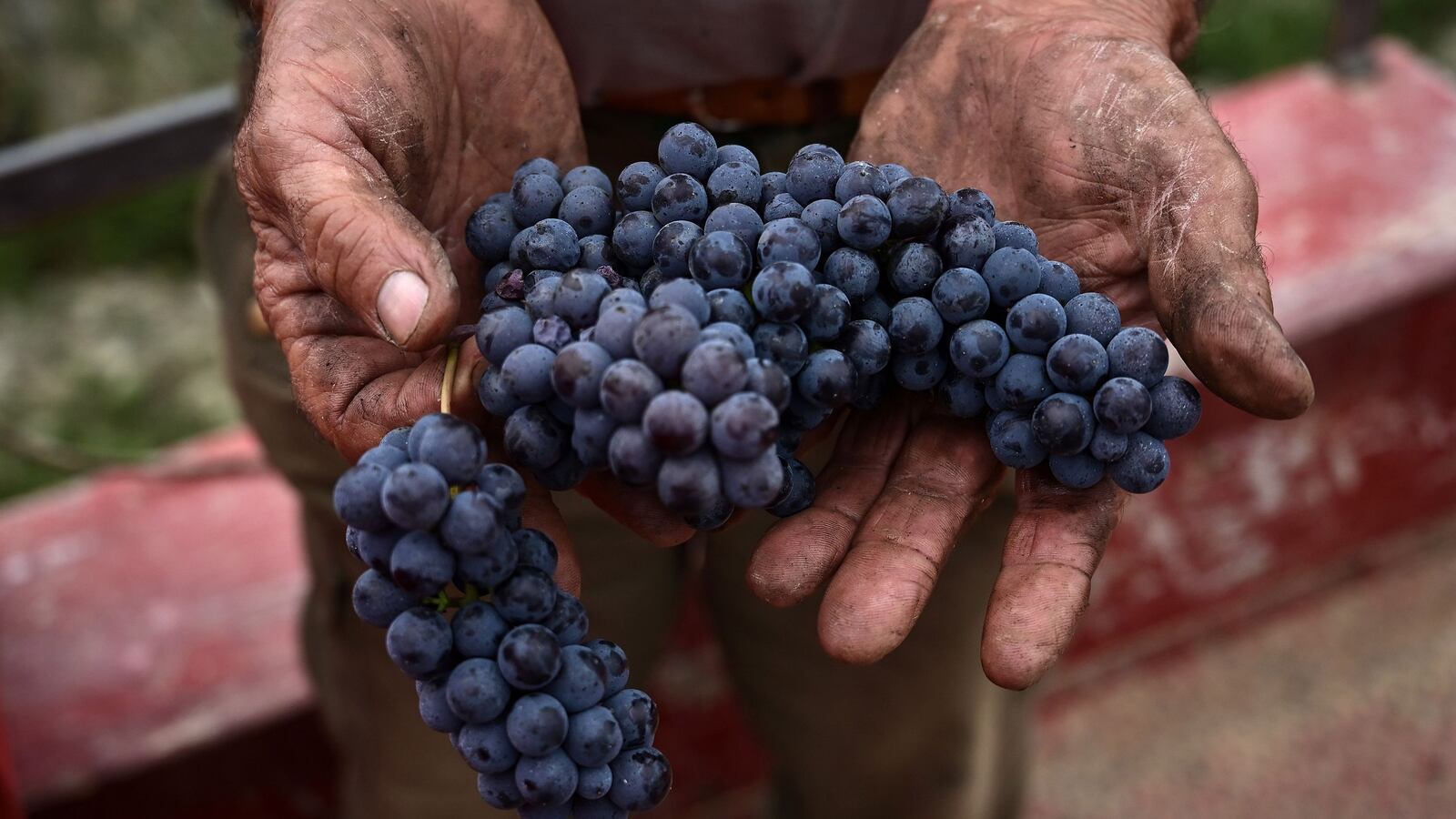At the end of the week in Milan, the four of us piled into the car to make our way to nearby Piedmont (Piemonte), one of Italy’s most revered wine regions, with property price tags to prove it. As the car hummed along, I looked out the window and melted into the comfort of watching the rolling green hills pass, bathed in warm autumn light.
As we approached the heart of the area, we saw there were vineyards in every direction; grapes appeared to be the only crop growing for miles. Nicola called wineries to determine where we could go for a tasting and a tour. His voice rode the roller coaster of the Italian language—a cascade of rolling Rs and vowels. He hung up after the third call. “Dai!!” he said, exhaling. C’mon!! No luck with that vineyard. “California wineries are so organized; like, they have time slots, depending on how many wines you want to taste,” he said, exasperated. “It’s not really like that in Italy.” The more pertinent truth was that we hadn’t thought ahead to call before that morning—you do need to make appointments to visit wineries in Piedmont, and we were late to the game. This was how I stumbled into Piedmont without knowing I was entering the Nebbiolo heartland.
Nicola connected with a family-owned winery offering a tour, and it was there that I had my first real encounter with Nebbiolo—one of Italy’s most adored grapes. “Nebby . . . what?” I asked Nicola.
“You’ve never said Nebbiolo?” he asked, shocked.
The late-ripening, early-flowering Nebbiolo grape is an Italian powerhouse grape: it’s what comprises the superstar wine Barolo and the beloved Barbaresco (both named after towns in Piedmont). Although Nebbiolo is one of the most renowned grapes in the wine world, it’s fair to say that a bottle of Barolo is more recognizable than the grape from which it comes.
When you see a wine named Barolo or Barbaresco, you know they’ve been made with 100 percent Nebbiolo grapes. Three-fourths of the Nebbiolo vines around the world are planted in Piedmont, and since I’d never been to Piedmont before, it’s not entirely surprising I wasn’t familiar with Nebbiolo. Of course, the further into the Italian wine world I ventured, the more I realized what a significant grape it is. Sommeliers and wine writers talk about it with glowing superlatives.
After visiting G.D. Vajra, a vineyard in Barolo, and getting a tour of their cantina and production areas, we walked into the sunny day, felt the warm Piedmont sun on our shoulders, and went to their tasting room next door. I sipped their red wine Dolcetto d’Alba (made of Dolcetto grapes—meaning “little sweet one,” although the wines produced from it are nearly always dry) and smiled at the harmony of flavors swirling in my mouth. Then I tasted their Barolo and felt like the stool had been pulled from under me—I was slow-motion falling into a world of a richly seductive wine. Holy cow. It was like the difference between a soft and pleasant peck on the cheek versus a profound kiss that sweeps you off your feet. This was the latter. I get why it has such a following.
After the tasting, we found a trattoria with outdoor seating in nearby Verduno; the ideal stop for lunch. It was a warm, sparkling afternoon, and would probably be one of the last crystal-clear days before more autumnal weather moved in. Nicola ordered a Barbera d’Alba (Barbera is another key grape in Piedmont, and Alba is a city just north of Verduno). The wine matched the day: it was bright, complex, drinkable, and nuanced with traces of a cherry-inspired sweetness.
We drained the bottle as we ate our antipasti, and then ordered a Barbaresco and enjoyed fresh agnolotti pasta—a regional spin on ravioli. The subtle hints of rose, fennel, and leather from the drink were like little side dish waterfalls of flavor to accompany the dish down the hatch. Both this Barbaresco and the powerful Barolo were made with 100 percent Nebbiolo? I was stunned. But they’re so different; how? Experts point to terroir as the main difference: the Nebbiolo grapes for Barolo are planted on a different angle of slope and are exposed to micro-climates determined by nearby rivers, altitude, and so on. This will cause the grape to react to fermentation differently than its siblings from other terroirs.

CHEESE, WINE, AND BREAD by Katie Quinn
HarperCollinsOne of the reasons we opted for Barbaresco with lunch was because it was the more affordable of the two (caveat: it’s not always less expensive). The thing that makes Barolo so expensive (and same goes for some bottles of Barbaresco) is that it takes a lot of time to be ready to drink; time softens the strong tannins, and you know what they say—time is money. Barolo is extremely tannic when it’s young, so it ages for three years after it’s harvested and before it can be released. For eighteen of those months it must be in an oak barrel. To be a Barolo Riserva, it needs to wait five years after the harvest to be released. Wineries store bottles of each vintage until they’re ready to be consumed, and that’s a sunk cost until the timer goes off. Barolo may be expensive to produce, but it’s a good return on investment.
Barbaresco doesn’t need to age quite as long; it can be sold after two years of maturation. Both wines are complex, but Barolo is fuller whereas Barbaresco is a bit brighter. There used to be a saying that Barolo was a wine of the kings and Barbaresco was a wine of the queens. Sexist, but you get what they were going for.
Another principal city in Piedmont is Alba, and it’s situated near the center of the Langhe wine region—there’s been evidence of Nebbiolo grown around Alba since at least the fourteenth century. To try a taste of great value from this outstanding Italian wine region, look for Langhe Nebbiolo. It’s a red wine from this area that is often from fruit of the same vineyards as Barolo, but it will only set you back twenty to thirty-five dollars (on average), versus forty to hundreds of dollars.
The explosion of Piedmont for its excellent wine has been swift and sturdy. If we had more time in Piedmont, we could’ve explored some of the region’s other grapes. It’s fair to say that some of lesser-known grapes in region are worth investigating, too. No grape is to be ignored in a country as fruitful as Italy.
We left the trattoria, immersed in a slightly buzzed cloud, and explored the rolling cobbled streets of the town before we found a soft patch of grass where we dozed in the sun. The next day, I said goodbye to my friends—although I should’ve known it wouldn’t be long before I’d see Maria and Nicola again. Ever since Connor and I moved to Europe, our paths crossed theirs more often than not.
From CHEESE, WINE, AND BREAD by Katie Quinn Copyright © 2020 by Katie Quinn. Reprinted by permission of William Morrow, an imprint of HarperCollins Publishers.

